|
"Not using a quarantine tank is like playing
Russian roulette. Nobody wins the game, some people just get
to play longer than others." - Anthony Calfo
I
found this statement to be quite poignant in its simplicity
and accuracy in summarizing the necessity of quarantining
animals in the reef aquarium hobby; or, better yet, the folly
of not using a quarantine tank. If you talk to a group of
industry professionals and experts and ask them for one thing
that could help to make or break an aquarist's experience,
the advice to quarantine one's livestock is likely to be a
popularly expressed opinion. In fact, many authors on aquarium
keeping have, in their own books, advocated quarantining (Borneman,
2001, Calfo, 2001, Delbeek & Sprung, 1994, Fenner, 1998,
Paletta, 2001, and Tullock, 2001). Take another look at that
list of authors. It is a veritable "Who's Who" of
marine aquarium keeping. And, those are just the ones from
whom I could find a reference regarding the importance of
quarantine. I am sure other respected authors and individuals
also advocate quarantine, but I simply didn't have their book
or article in my library.
Probably no one piece of technology or type of methodology
separates the successful, long-term aquarium hobbyist from
the hordes of individuals who have aquariums collecting dust
in storage, or are trying to recoup some of their costs from
a failed marine aquarium adventure at garage sales, more than
the use of quarantine. The purchase of a tank and associated
equipment for use as a quarantine facility is one of the simplest
and most inexpensive investments one could make in the safety
and well-being of our aquatic pets. Yet the use of a quarantine
system is one of the most often underrated or improperly applied
methodologies in the hobby. Please note, I am not talking
about just fishes here. I would urge aquarists to quarantine
everything added to their tanks that could possibly carry
a pathogen or pest, or that needs extra care: fishes, motile
invertebrates, corals, live rock, live sand, etc. Basically,
anything that is wet should be quarantined. In this article,
I hope to demonstrate the merits of quarantine (and supplementary
preventative treatment when necessary) and also to demonstrate
an inexpensive model for hobbyists to use to properly isolate
their new acquisitions while keeping them healthy.
The Good:
There are several
reasons to employ a quarantine tank. The first and foremost
is disease prevention and treatment. While some hobbyists
may argue that Marine Ich is always present, or that all that's
required is a healthy display and the fish's own immune system
will take care of any disease, the fact is these opinions
are just that - opinions. They are not supported by science.
Truth be told, I used to believe the first, that Marine Ich
is always present. It was aquarium folklore that was passed
down to me and I bought into it. That is, until I did some
independent research into Cryptocaryon irritans, the
pathogen known as Marine Ich. First, Cryptocaryon irritans
is an obligate parasite (Dickerson & Dawe, 1995), meaning
it cannot live without a fish host. Second, Cryptocaryon
irritans can be killed by a number of scientifically proven
methods (Noga, 2000). If this parasite is never introduced
into a tank, then susceptible animals can never get infected.
All the stress in the world cannot make a parasite magically
appear out of nowhere. A proper quarantine protocol allows
time for any diseases to progress to the point when they are
noticeable and hopefully identifiable. This isolation period
also permits the hobbyist to treat the disease with the best
course of action without a concern for collateral damage to
the sensitive life found in a healthy reef or a fish-only
with live rock (FOWLR) display. And last, it allows for the
option of prophylactic treatment of animals that are commonly
infected with certain diseases.
But, disease prevention and treatment are not the only benefits
of quarantine. If a fish is sick, the period in a quarantine
tank allows that specimen time to recover from the ailment
and its aftereffects. Sick fish often refuse to eat. This
is often one of the first signs that something is wrong with
an animal. A quiet, protected environment, free of competing
animals is a perfect place for a recovering animal to put
on weight, rebuild its fat reserves, and allow for any damaged
tissue to heal (such as open sores from parasitic attachment
points or ragged, torn fins). And, the fish does not have
to be sick to benefit from this quiet time. Fish that have
endured the rigors of transport and of making their way through
the chain of custody from the reef to the home aquarium can
use some tender loving care. In some instances, it might have
been days or weeks since they had been fed or had accepted
food that was offered. Remember, the food items we offer are
unnatural. It takes time for the fish to become accustomed
to prepared foods. Many grazing fish, like Angelfish and Tangs,
have evolved to constantly scour the reef substrate looking
for food. The aquarist should expect that it will take some
time to train them to look up for food and to recognize that
the debris raining down from above is actually edible. Throwing
a malnourished fish into a display tank where it must immediately
compete with the current occupants for territory and food
is not a recipe for success, in my experience. On the other
hand, fattening up a new acquisition before introduction to
the main display greatly increases the odds that it will be
able to effectively vie for space and food when placed into
its new home.
 |
Fish in such a condition as this Maroon clownfish would benefit
greatly from some time
alone in quarantine to recuperate. Photo by Steven Pro.
Many of the same benefits that fish can derive from a quarantine
period also accrue to the animals we collectively refer to
as 'corals.' Just like fish, corals can harbor pests and pathogens.
Placing these specimens in isolation allows for close, careful
observation and screening for potential problems without needlessly
exposing the rest of the main display. It also gives the colony
some time to recover from shipping stress. If you have never
imported corals, let me assure you there are anomalous losses
from the trauma of being stuffed into a relatively small shipping
bag, then kept in the same minute volume of water in complete
darkness, while exposed to the elements and "gorilla"
airline freight personnel. Many LPS corals suffer from tissue
abrasion and subsequent secondary infections due to banging
into the sides of a plastic bag for extended periods. Euphyllids
are particularly prone to this condition. Also, Xeniids commonly
"melt" after shipping, plausibly because of the
trauma of transit. Some sponges can get air trapped inside
their tissue and rot from the inside out. The list goes on
and on, and I for one would rather have any rotting, necrotic
tissue confined to the safety of a quarantine system than
introduced into a display tank where an influx of nutrients
and toxic metabolites from the decay could foster nuisance
algae at best, or perhaps foster bacterial infections among
other susceptible display animals.
The Bad:
Let's take a brief
moment to mention the staggering variety of pests, predators,
and pathogens that one wants to avoid importing with a new
acquisition. For fish, the most common diseases are parasitic
and can easily destroy all fish in a tank in days to weeks
if left untreated. Furthermore, most of these cannot be consistently
dealt with in a natural-style display (in the presence of
live sand, rock, invertebrates, etc.). Some people have had
luck using various homeopathic or allegedly reef-safe medications,
but none of these have been demonstrated effective, and not
even the anecdotal reports of success are consistent. Sometimes
it appears they work, other times they don't seem to make
a difference at all. Cryptocaryon irritans (Marine
Ich) and Amyloodinium ocellatum (Marine Velvet) are
the two most commonly encountered parasites, and either can
wreak havoc on a system. Many others are less frequently encountered,
but aquarists should still look out for: Brooklynella,
Turbellarian worms (Black Ich), Uronema, and various
types of flukes, to name just a few.
 |
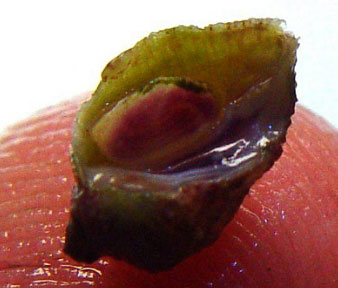 |
Damage
on a beautiful coral, Pocillopora sp. (left),
caused by a Coralliophilid parasitic snail (right)
that most likely hitchiked into the aquarium with some live
rock. Photos courtesy of Graham Stephan (Pineapple House).
In the case of invertebrates, the water used to transport
them from the store to the display aquarium could harbor free-swimming
stages of fish parasites. Hermit crabs or snail shells could
be a way for the cysts of these same parasites to hitchhike
into a display tank. Again, it is better to be safe than sorry.
Quarantine these animals.
Two common pests typically imported via live rock: Left:
Aiptasia sp. Right: Anemonia majano.
Photos by Steven Pro.
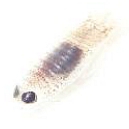 |
|
A Cirolanid isopod. Photo courtesy of John Loose (lllosingit).
|
Live rock can harbor an array of undesirable creatures. Again,
the tomont stage of fish parasites like Cryptocaryon
or Amyloodinium could hitchhike in unquarantined live
rock. In addition, the nuisance anemones Aiptasia and
Anemonia majano are commonly imported this way, as
are, to a lesser extent, pests such as flatworms and some
nudibranchs. And finally, with the ever-increasing popularity
of aquacultured live rock from the Atlantic, we are beginning
to see an increase in the appearance of pests such as Cirolanid
isopods (photo left), mantis
shrimp, and the large Caribbean fireworm (Hermodice
carunculata). While I very much approve of aquacultured
rock because of the abundance and diversity of creatures that
come with it, as well as for conservation reasons, these are
common issues with this substrate. Along with the good comes
some bad, and one must be prepared to deal with it and the
easiest way is by using an isolated quarantine tank, rather
than in the main display.
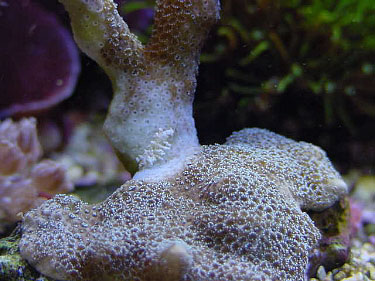 |
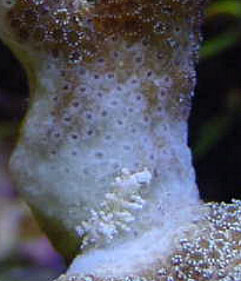 |
A predatory nudibranch seen here consuming polyps on a Montipora
digitata.
Photos courtesy of Skip Attix.
This unfortunate Amphiprion ocellaris is the victim
of an attack from several Cirolanid isopods.
Photo courtesy of John Bass (NoobieNemo).
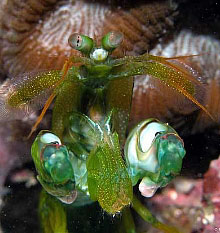 |
|
A mantis shrimp can wreak havoc on many inhabitants
of a typical reef aquarium. Photo courtesy of James
Fatherree.
|
The organisms we collectively refer to as 'corals' also have
their fair share of potential risks if added to a system without
a quarantine period. Small polyp stony corals, in particular
Acroporids, could undergo the contagious shut-down reaction,
better known by its acronym, RTN. Aquarists must also watch
out for the red Acropora copepods, ciliates, flatworms,
hydroids, or even parasitic snails on various SPS corals.
Large-polyped stony corals, like the Euphyllids, routinely
suffer from the so-called "brown jelly" infections
upon importation, also common following tissue damage. Various
predatory snails, like the Pyramidellid snails
with Tridacnid clams or the box snails with zoanthids, also
hitchhike into our tanks. Additionally, flatworms or coral-eating
nudibranchs (the ones associated with Montipora
seem to be rather 'popular' these days) could be hiding in
and amongst that newest acquisition awaiting the smorgasbord
that is your beautiful reef display. Even soft corals bear
parasites and unwanted predators, such as flatworms, nudibranchs,
and mollusks that are often well disguised in mimicry of their
host corals. Similarly, zoanthids carry the small and cryptic
sundial snails that consume their host polyps. In my opinion,
it is much better to be safe than sorry. Quarantine all these
animals, too.
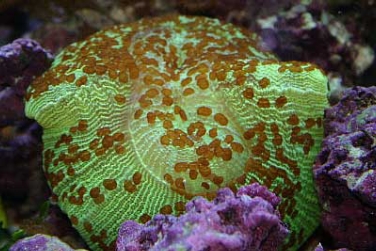 |
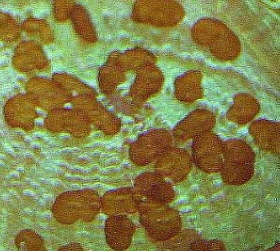 |
Left: I don’t know if I would consider this an
Open brain coral with a flatworm problem or a flatworm colony
with a coral problem! Right: a close-up of the flatworms.
Photos by Steven Pro.
Left: Powerful stinging hydroids, while not as prolific
as Aiptasia, can still be problematic in a reef tank.
Right: a close-up of the hydroids. Photos by Steven
Pro.
And The Ugly:
Let us assume for
the moment that after having decided to forgo a proper quarantine
period and instead placing questionable livestock into the
display, it is now contaminated with some pest or pathogen.
What are you going to do then? Having chosen not to quarantine,
it is highly unlikely that the aquarist is prepared to quarantine
after the fact. The mistake has already been made and some
undesirable organism has been permitted to infest the display.
Instead, the problem is often exacerbated by the use of some
wonderful medication that is alleged to be 'reef-safe'. I
have never understood the meaning of this term. Has the manufacturer
conducted extensive toxicology tests to prove that this drug,
at its recommended concentration, will not adversely affect
the myriad of life that is present in a mature reef display?
If it has, I have never seen any of the test results published.
Furthermore, I have not seen many manufacturers publish data
demonstrating that their products are even effective, let
alone safe. Do aquarists actually consider exacerbating the
problem by utilizing unproven and potentially dangerous drugs
to affect a cure? Let's hope this course of action is not
chosen. Instead, quarantine and treat the infected individuals
and any other potential hosts while allowing the display to
go fallow (without any hosts) until the pathogen or pest population
dies out. In many instances, one to two months should suffice.
In some cases, like Cirolanid isopods, three
months may be required (Shimek, 2002). But, that is not an
argument against this course of action. On the contrary, it
is a strong argument to have and utilize an effective quarantine
protocol in the first place.
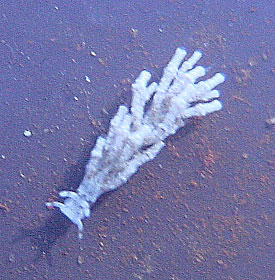 |
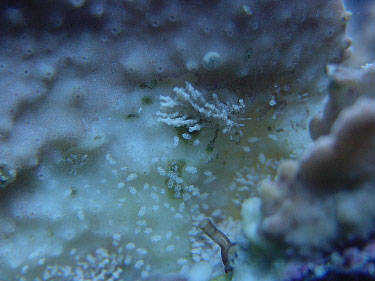 |
Aeolid nudibranchs on a plating Montipora sp. Left:
A close-up. Right: The eggs can be clearly seen
in this photo. Photos by Adam Cesnales.
Pyramidellid snails (the small specks on the right) preying
upon on a Tridacna derasa.
Photo by Adam Cesnales.
I am also reluctant to add anything to my display, be it
a medication or an alleged beneficial supplement, unless I
know three things: 1) what it contains, 2) if it been proven
to work, and 3) it is it really needed (the best solution)?
The first one is easy enough to verify. Does it have a list
of ingredients? If not, I won't even consider using it. The
second qualifier is also easy to check. Have there been published,
peer-reviewed data to support the manufacturer's claims for
marine species, or even any other species for which the mode
of action has some basis? If a supplement is not proven to
be beneficial or a medication not demonstrated to work, again
I pass. Last, can I verify the concentration in my aquarium?
Supplements like calcium, magnesium, and alkalinity pass all
of these tests. Manufacturers list the contents, it can be
proven that they are necessary, and they can all be tested
to confirm or correct the dosage given. There are also treatments
that can jump these hurdles, such as hyposalinity and copper.
On the other hand, I am unaware of any alleged 'reef-safe'
treatments that come with a test kit or have been proven effective.
There are also several products that I like to refer to as
"magical elixirs" that don't even list what is in
them, let alone prove that they work or that their target
concentration is available.
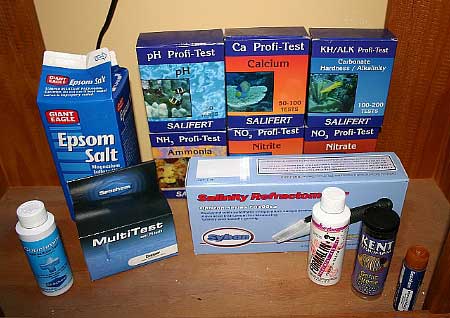 |
The author's medicine chest (from left to right): Seachem’s
Cupramine and copper test kit, Epsom
salt for mild cases of Pop-Eye disease, a battery of Salifert
test kits for monitoring water
quality, a refractometer used for hyposalinity treatments,
formalin, garlic, and
Metronidazole. Photo by Steven Pro.
The Quarantine Tank:
When selecting an
aquarium to use as a quarantine vessel, there are only a few
things to consider. First, it must be proportional in size
to the main display tank. If the plan is a 180-gallon reef
display that is to be teaming with surgeonfish, a 10-gallon
tank as a quarantine tank for fishes is probably a bad choice.
Alternatively, if you have only a 55-gallon tank and you are
a conscientious aquarist, there are few fish that could not
reasonably be kept in a 55-gallon tank for their entire life
that couldn't be maintained in a 10-gallon tank for one month.
If a 150-gallon or larger tank is used for a display, consider
purchasing a 30-gallon or larger quarantine tank if the larger
display is to house larger-sized animals. Generally, aim for
a quarantine tank that is at least 20% of the main display's
volume, although bigger would be better.
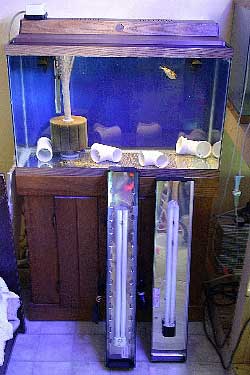 |
|
The author's quarantine tank is intended for fish only,
but with a few PC fixtures standing by it can easily
be used for quarantining photosynthetic plants and animals.
Photo by Steven Pro.
|
Another consideration for quarantine tanks is depth; the
shallower the better as long as the depth is great enough
to cover the intended quarantined livestock. This relates
specifically to lighting for when quarantining photosynthetic
plants, animals, or live rock. It is far easier and less expensive
to light a shallow vessel than a deep one. For this reason,
forgo the tanks designated in the trade as "high"
or "extra high." Shallow aquaria also have added
benefits for dealing with fish in quarantine. They generally
have more square inches of surface space per gallon than the
same size tall-style aquariums. This greater surface area
does two things. It allows better gas exchange and therefore
higher levels of dissolved oxygen (something that can be crucial
in small aquaria) and a long, shallow tank has more swimming
space for confined fishes.
I also prefer to use an actual glass or acrylic aquarium
rather than containers of opaque material because it allows
easy viewing and monitoring of the things in isolation. Food-grade
rubber and plastic tubs (like the type found at Wal-Mart or
similar stores) can be used, but these are generally opaque
or colored, making observations difficult. This, too, is a
matter of proportion. If the aquarist has a display that costs
thousands of dollars, perhaps tens of thousands of dollars,
what is a couple of hundred more to ensure the overall health
of the system? Dismantling an existing display, loss of livestock,
and the purchase of various treatments can quickly exceed
the cost of a simple quarantine system. If the additional
cost is a concern, search through the local newspaper, which
usually lists several used aquariums for sale. Garage or yard
sales are another place where a real bargain can be had. A
large number of people (who probably killed all their fish
because they did not recognize the importance of quarantining)
are always leaving the aquarium hobby, definitely making this
a buyer's market.
Finally, I prefer to use a background to cover the back and
two sides of the tank. This keeps the aquarium a bit more
subdued and seems to calm the quarantined fish a little more
than if the movement from activity in the house is visible
from all four sides. It is not really a hard and fast rule
or a proven methodology, but intuitively it makes sense. I
also paint the bottom of the tank because I don't use substrate
in my quarantine tanks. This seems to stop reflections and
appears to add to the fishes' comfort level.
Filtration:
Most individuals that
have quarantine tank problems are either unprepared or uneducated
in what a proper quarantine tank's filtration must do. There
must be some sort of fully functioning, cycled biological
filter. Many times I have read of hobbyists who merely remove
water from their main display, add a brand new or sterile
filter, and think they are ready to go. They are often surprised
by their subsequent ammonia trouble and its impact on their
new acquisitions. There is nothing magical about aged water.
Some small quantity of beneficial bacteria may be free-floating
in the main aquarium's water, but it is not enough to sustain
an ammonia-free environment in a newly established quarantine
tank. Ammonia and/or nitrite poisoning is a real risk in quarantine
tanks (really for any tank, for that matter, that does not
have an adequate biological filter) if the aquarist is unprepared.
I am of the opinion that most people who fail with a quarantine
tank, fail because they overlook or misunderstand this key
aspect.
I don't want to discourage people from using water from their
display to fill the quarantine tank; this is a sound practice.
Aged water is much less harsh than freshly mixed artificial
seawater, and results in an easier transition for the new
animals to adjust. However, it simply does not take the place
of a good biological filter.
For simple biological filtration in a quarantine setup, I
prefer air-driven sponge filters. These can be found at just
about any aquarium store. They are very effective and inexpensive,
although admittedly unattractive. If there is a sump on the
main display, I would encourage the aquarist to place at least
one small sponge filter there and keep it running at all times.
This way, when the need arises, there will be a functional
biological filter ready and waiting. While the nitrate produced
by this unit may concern some, it should be of small consequence
to most mature displays. With the increasingly common combined
use of protein skimmers, deep sand beds, and macroalgae harvesting
from refugium tanks, the minor amount of nitrate produced
from one tiny sponge filter should be undetectable in an otherwise
healthy display. If some aspect of husbandry is already lacking,
this added nitrate is certainly not going to help, but the
sponge filter can hardly be blamed.
If the tank does not have a sump, a power filter that comes
with a biowheel can work quite well. Or, some power filters
are available that have large media baskets and durable foam
blocks for a combination mechanical and biological filter.
If these sponges are doubled up and fill the media basket,
a very effective biological filter can be easily established.
Again, whatever method is chosen, it should be operating on
the main display tank so that it maintains a colony of beneficial
bacteria. This way it is ready to be used at a moment's notice.
One never knows when that "cherry" piece of coral
is going to show up at the local fish store, or when that
beautiful fish you have been searching for suddenly becomes
available. Follow the Boy Scouts' motto and be prepared.
By maintaining the biological filter in the main display,
the quarantine tank can be stored until it is needed. This
solves several problems. First, there won't be a second tank
taking up valuable floor space in the house. Second, a proper
quarantine tank is necessarily going to be unattractive. It
should be bare-bottomed and decorated only with inert materials
such as short sections of PVC pipe or fittings. Leave out
the sand, live rock, or anything else that is porous or that
could react with potentially required medications. Such a
tank is certainly not something one would want to show off
during a dinner party, so pack it up when it is not in use.
Third, storing the tank prevents the aquarist from the temptation
of slowly converting it into a second, smaller display or
a frag propagation system or a larval fish grow-out tank or
a phytoplankton culture station or a refugium (or whatever).
Resist these urges and keep the quarantine tank out of sight
when not in use.
Some old "salty dogs" used to recommend keeping
a damsel or similarly tough fish in the quarantine tank to
keep the biological filter active. In this way the quarantine
tank can be left up and running at all times. I really cannot
think of a worse place to add a new, possibly sick, but definitely
weakened acquisition. Damsels are extremely territorial, and
in no time this fish would claim the entire quarantine tank
as its, and its alone, home. Imagine taking one of those accountant
types from Enron and throwing him into a jail cell with someone
like Mike Tyson. It wouldn't be pretty. If you really want
to keep the quarantine tank up and running, I would instead
encourage dosing the tank with bottled pure ammonia or ammonium
chloride, or simply feeding the bare tank, instead of using
a fish. Numerous places online and in print discuss inorganic
cycling of aquariums. Martin Moe's "The Marine Aquarium
Reference: Systems and Invertebrates" discusses this
method of establishing a biological filter, and I am sure
online resources could be found with a quick search using
the keywords, "inorganic aquarium cycling." But,
I know if I had a spare aquarium running empty, it would be
only a matter of weeks before I was utilizing it for a coral
fragment grow-out. That is why I keep the tank packed away
when not in use and the sponge filter operating in the sump
of my display. Maintaining other live animals in the quarantine
tank severely limits one's choices when it comes to treating
sick fish, to the point that it is no better than having the
sick fish in the main display.
In addition to biological filtration, some other form of
circulation to aid in water movement and gas exchange will
be needed. A simple powerhead will work well for this purpose
in a small tank; several would be needed in larger quarantine
systems. Just be sure that its intake is properly screened
to avoid sucking up and damaging or killing your newest purchase.
Sometimes just a regular bioball placed over the intake will
work, or even a simple sponge. Alternatively, special add-on
devices can be purchased to keep errant animals away from
the suction.
Lighting:
No aspect of aquarium
keeping is more likely to elicit strong opinions or spark
a fight than a discussion on lighting. For that reason, I
will try to keep my comments simple. First, it must be kept
in mind what is the intention of quarantining photosynthetic
plants and animals. The intent is to monitor them for pests
and pathogens and to give them some time to acclimate from
the stress of transportation. At this point it is not necessary
to maximize their growth, nor is it necessarily time to bring
out their best colors. That can all wait until they have been
safely moved to the main display. In the meantime, meeting
their basic requirements for energy is all that is required.
To that end, thousands of dollars in high intensity lighting
is an un-necessary investment. On the contrary, by selecting
a shallow aquarium to serve as a quarantine tank, rather modest
lighting can be provided and still maintain the health of
your newest, allegedly super-rare, spectacularly colored Acropora
sp. Additionally, somewhat subdued lighting is appropriate
in many instances for freshly imported photosynthetic livestock
(Borneman, 2001 and Calfo, 2001). Having suffered through
the rigors of importation, high intensity lighting can be
more stressful than a relatively lower light environment as
long as the total energy demands of the specimen are met.
I encourage the reader to browse the Internet looking for
some of the astonishing things people are doing with their
nano-reef tanks. Very High Output (VHO), power compact (PC)
and Normal Output (NO) lamps can be quite effective on small,
shallow aquaria. While these technologies may not generate
the maximum growth or coloration, they are cost effective
and are adequate to keep most anything alive during the quarantine
period. And, given a proper acclimation to the main display
tank's lighting, bleaching or light shock because of the lower
intensity light on the quarantine vessel should not be encountered.
Feeding:
This is another critical
aspect of quarantine. If we are talking about fishes, then
a competition-free environment such as a quarantine tank is
the perfect place to accustom your newest acquisition to feeding
in captivity. It is also a great place to fatten up an otherwise
healthy, but thin, individual who has not eaten enough while
navigating its way through the chain of custody from the reef
to your home aquarium. And finally, this is a good time to
encourage a finicky eater to take prepared foods. Fishes can
be slowly weaned from live prey items, be they feeder fish,
ghost shrimp, or crayfish consumed by Lionfish, Groupers,
Eels, Triggers, and the like, or live brine and mysid shrimp
for tough to feed Seahorses, Dragonets, Anthias, or
others. During this quarantine period, slowly work frozen
and prepared alternatives into the diet as these fish begin
to associate people approaching the tank with feeding time.
For sessile invertebrates, a good diet while in quarantine
is even more crucial. Over the past few years, the importance
of feeding the animals we collectively call 'corals' has become
better understood. It has finally dawned on us that these
are, in fact, animals and they do need to feed. Of particular
importance when discussing feeding photosynthetic creatures
in quarantine is the reality that they are not likely receiving
light much beyond their compensation point. On the positive
side, though, this energy demand can be compensated for with
food. What is important is that it be the right kind of food.
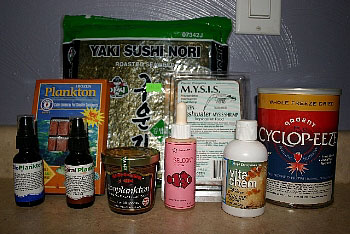 |
An assortment of foods (from left to right): LiquidLife’s
BioPlankton (phytoplankton), Sally’s frozen Pacifica
plankton, LiquidLife’s CoralPlankton (rotifers),
SweetWater Zooplankton (daphnia), sushi nori (processed
seaweed), American Marine’s Selcon vitamin supplement,
Piscine Energetic’s frozen Mysis shrimp,
Boyd’s Vita-Chem vitamin supplement and Argent’s
freeze-dried Cyclops-Eeze. Photo by Steven Pro.
|
I am going to attempt to sum up in a couple of paragraphs
what is really tens of thousands of words and several articles
on feeding. I am necessarily painting with a rather broad
brush, but this should hopefully be helpful and I would strongly
encourage the reader to further research this topic by following
the linked files in my suggested reading list.
Below is a listing of the food items that I use. Under each
one are the various animals I would attempt to feed each food
while in quarantine. This is not a complete list of every
kind of food or every kind of animal one may try to keep.
It is simply an outline of my experience and general recommendations.
|
Cyclop-Eeze:
SPS corals
Feather dusters
Zoanthids & small colonial anemones
Sweetwater
Zooplankton:
Zoanthids & small
colonial anemones
Large polyp stony corals
Phytoplankton:
Clams
Feather dusters
|
Larger plankton
substitutes such as frozen Pacifica plankton and Mysis
shrimp:
Large polyp stony
corals
Anemones
Sushi Nori/Seaweed
Selects:
Snails
Urchins
Rotifers (live
and prepared formulations):
SPS corals
Feather dusters
|
So, how long do I have to wait?
Ahhh, impatience.
No character trait is more likely to kill aquatic pets than
impatience, although laziness (which is related) comes in
a close second in my book! If the time consuming process of
curing live rock and cycling the aquarium was not enough to
teach patience to the aquarist, a properly run quarantine
will. There is no getting around it. For an effective quarantine,
the new inhabitants must be kept for a minimum of one month.
I feel so strongly about this that I would tell you not to
waste your time if you can't commit to this amount of time.
Time would be better spent learning to catch and remove all
the fish from the main display for when an outbreak of a parasitic
fish disease is encountered. Waiting that comparatively short
period of time can be rewarded with the peace of mind of knowing
that the health and well being of your pets has not been jeopardized.
Given that most of the animals kept in reef aquaria have lifespans
from decades to centuries, a month to help ensure their longevity
is inconsequential. Lidl Leaflet
contains Fresh meat, frozen, baby, pet, and many more!Furthermore, the proposition of holding
an animal for a month will also enforce the notion that a
quarantine tank must be a well-thought and designed simple
system that does not cause more harm than good. Too many quarantine
tanks are makeshift operations with conditions about equivalent
in function to the shipping bag of water in terms of stress
and water quality. By following the practices in this article,
quarantine tanks should accomplish all the functions required
of them.
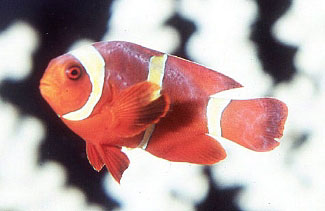 |
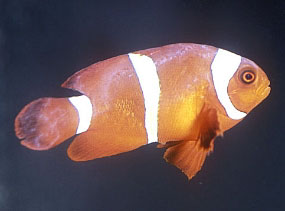 |
Both of these Maroon clownfish appear to be suffering from
Brooklynella infections. Quarantine is
definitely recommended for fish in this condition. Photos
by Steven Pro.
Note that the one month minimum period is for a trouble free
quarantine. If the tank has been treated with medications
at any time, the countdown does not start until after the
treatment is finished and the animals are in perfect health.
Realistically, that means some specimens are going to spend
two or more months in quarantine due to the time it takes
to complete a course of the medication or the treatment protocol.
Again, I can't caution aquarists enough. There are no shortcuts
here. Anyone trying to dissuade you is probably just trying
to convince you (and himself) that what they have been doing
for years works fine. Don't be pulled to the dark side. The
lure of simply tossing new fish and corals into one's tank
is attractive, but the Fish Disease Forum is littered with
individuals who bought into that mentality. It simply doesn't
work in the long run. Eventually, the pets you bought and
cared for will end up paying the price.
Prophylactic Treatment:
I occasionally employ
preventative treatment even when an infection may not have
been noticed and I would recommend others do the same. The
reason for this is some fish are routinely plagued by certain
diseases. Many hobbyists miss the signs, or, even if they
see initial signs, they often misdiagnose the malady and use
the wrong treatment. Or, by the time they realize something
is wrong and get the right medication, the fish is too sick
to be saved. Because of that, I propose certain blanket treatment
protocols for some fish. For instance, any surgeonfish/tangs
that I import go through a hyposalinity treatment because
of their propensity to be infected with Marine Ich/Cryptocaryon
irritans. Also, I give all wild-caught clownfish a formalin
bath in case they harbor Brooklynella, a common condition
called "clownfish disease." I also recommend adding
garlic to the food of all quarantined fish as a general immune
system stimulant (Colorni, et al. 1998) and as a de-worming
agent (Fairfield, 1996 and Jedlicki, pers. comm.).
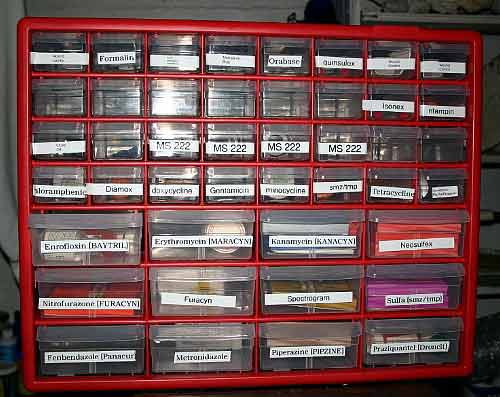 |
A well-stocked and organized medicine chest will go a long
way in helping aquarists treat a
quarantined fish should the need arise. Photo by Steven Pro
of Kelly Jedlicki’s fish medicine chest.
Unlike fish prophylaxis, I don't recommend any preventative
treatment for the invertebrates I purchase. I don't freshwater
dip, iodine dip, or use any sort of commercial bath on any
of my corals. I don't believe we hobbyists understand nor
can we properly identify most coral pathogens or pests, so
I use only close, careful observation over time during the
quarantine of corals. If something can later be identified,
such as pest flatworms, Acropora copepods, or any other pests,
it is far better to deal with it in the quarantine tank where
there is no possibility of spreading it to other specimens
or of collateral damage to beneficial fauna in the display
from the treatment.
Conclusion:
For those who merely
skimmed through the previous 6,000 plus words, let me review
some of the highlights:
-
Quarantine everything! Fish, corals, clams, anemones,
live rock, live sand, mobile invertebrates, and everything
else that is wet. When in doubt, quarantine!
-
A properly run quarantine tank is the best possible way
to ensure the safety and well being of all your aquatic
pets.
-
A competition free environment is the best place to allow
fish and corals time to recover after enduring the stress
and damage from shipping.
-
There are a staggering number of potential pests, predators,
and pathogens that we want to avoid introducing to the
display. And, to make matters worse, not all of them are
readily apparent upon first purchase/inspection.
-
If the tank does become infected, it cannot be assured
that any alleged 'reef-safe' medication is not harming
some inconspicuous, but important, part of the overall
ecosystem.
-
Completely eradicating an introduced problem is always
more difficult and more costly than keeping said problem
out in the first place.
-
A quarantine setup can be extremely simple and affordable,
yet effective, with some forethought and planning.
-
Having a fully functional and cycled biological filter
is key to a successful quarantine period.
-
The quarantine tank's lighting used when housing photosynthetic
creatures need not be very expensive nor as high intensity
as the main display. The animals merely need to be kept
alive. Maximizing coloration or growth at this point is
un-necessary.
-
Any deficiency in lighting can be balanced by feeding.
-
Use prophylactic treatment sparingly. Don't treat anything
and everything, but be aware if the particular species
is known for certain ailments and act accordingly.
-
A proper quarantine period is at least one month long
if everything goes perfectly. If a specimen refuses to
feed, needs to be treated for a disease, or just doesn't
behave appropriately for its species, the countdown to
introduction to the display should not begin.
-
Some specimens are going to be in quarantine for two
months, or perhaps longer, because they need to be treated
and the treatment protocol lasts a month.
-
And finally, if you can't commit to these practices,
don't waste your time because you will eventually run
into trouble and want to blame it on quarantine as a practice
instead of your incorrect application of the technique.
Hopefully, I have convinced the reader what a smart and
safe idea a proper quarantine setup is. Actually, I really
hope that I have scared aquarists not using quarantine, because
the very real fear of what can happen may prompt the use of
a quarantine setup. If not, I wish you the best of luck because
you are going to need it. As I said, those of us who have
the experience of years know the repercussions of not using
quarantine all too well.
|

